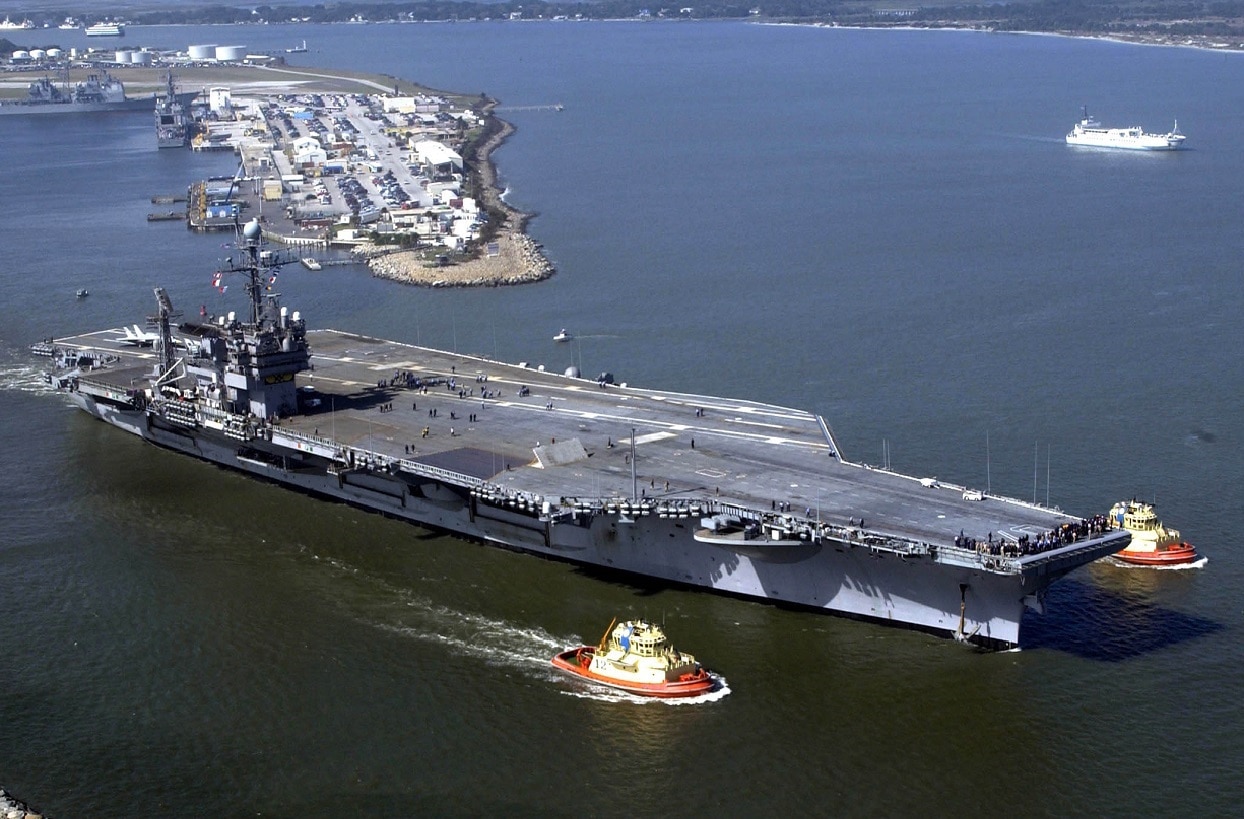The United States Navy currently operates eleven nuclear-powered aircraft carriers, and every other carrier in the world – apart from the French Navy’s flagship Charles de Gaulle – is a conventionally powered vessel. However, as recently as 2007, the U.S. Navy also operated a non-nuclear carrier, the USS John F. Kennedy (CV-67). A variant of the Kitty Hawk-class, she was the last conventionally powered carrier built for the Navy.
USS John F. Kennedy: A Short History
Originally scheduled to become the fourth Kitty Hawk-class carrier, she received so many modifications during construction that she instead formed her own class. Named in honor of the late 35th President of the United States, she was laid down less than a year after President Kennedy was assassinated in Dallas, Texas in late November 1963. Launched on May 27, 1967, just two days prior to what would have been his fiftieth birthday; the warship was sponsored by Caroline Kennedy, the late president’s then nine-year-old daughter.
Her nickname was “Big John” and her motto was fittingly “Date Nolite Rogare” – Latin for “Give, do not ask.”
Initially commissioned as an attack aircraft carrier CVA 67, she was redesignated as the multi-purpose carrier CV 67, which also indicated that the vessel was capable of supporting anti-submarine warfare aircraft. USS John F. Kennedy entered service too late to see service in the Vietnam War, but nearly a decade and a half after entering service the carrier deployed aircraft in combat operations during the Multination Force in Lebanon in 1983. Tragically, A-6E pilot Lt. Mark Lange was shot down and killed by surface-to-air missiles during a December bombing raid on Beirut.
Five years later two F-14 Tomcats from the VF-32 “Fighting Swordsman” were launched from the carrier to intercept Libyan MiG-23 “Flogger” fighter aircraft in the Gulf of Sidra. During the course of the intercept, the MiGs were determined to be hostile and both were successfully shot down.
On January 17, 1991, John F. Kennedy‘s Carrier Air Wing 3 (CVW 3) took part in the very first strike operations against Iraqi forces as part of Operation Desert Storm. During the operations the carrier launched a total of 114 airstrikes while the aircraft flew a combined 2,900 sorties against Iraq, delivering more than 3.5 million pounds of ordnance. Just four years later the carrier was transferred to the Naval Reserve Force as an operational reserve carrier with a combined full-time active duty and part-time Naval Reserve crew.
John F. Kennedy returned to the active fleet in October 2000 and then in 2002 was deployed in support of Operation Enduring Freedom, during which she dropped 31,000 tons of ordnance on Taliban and Al Qaeda targets.
The End of the Line
Even as the U.S. military engaged in the Global War on Terror (GWOT), it was determined in 2005 that the conventionally powered warship was the most costly carrier in the fleet to maintain and she was due for an expensive overhaul. Instead of the overhaul, the decision was made to retire the carrier – marking the end of the line for the U.S. Navy’s conventional carriers. Yet, prior to the decommissioning, she took part in a farewell tour and made a number of port calls, including a stop at her honorary “homeport” of Boston. She also took part in a final New York City Fleet Week in 2005 and was then decommissioned in Mayport, Florida on March 23, 2007.
There had been multiple attempts to preserve the ship as a museum, and the Navy had even placed the vessel on donation hold with numerous city’s expressing interest in saving Big John. However, those efforts stalled after Portland, Maine’s city council opted against bringing the ship to the city. Finally, in late 2017, the Navy revoked the “donation hold,” and in August 2018 it was announced that ship would be dismantled.
Still, the legacy of President Kennedy lives on as the second Gerald R. Ford-class carrier, CVN-79, will also bear the name of the late president. Once again sponsored by Caroline Kennedy, the new carrier is currently fitting out. When she enters service in the coming year her even more fitting motto will be “Serve with courage.”
Peter Suciu is a Michigan-based writer who has contributed to more than four dozen magazines, newspapers and websites. He regularly writes about military small arms, and is the author of several books on military headgear including A Gallery of Military Headdress, which is available on Amazon.com.

